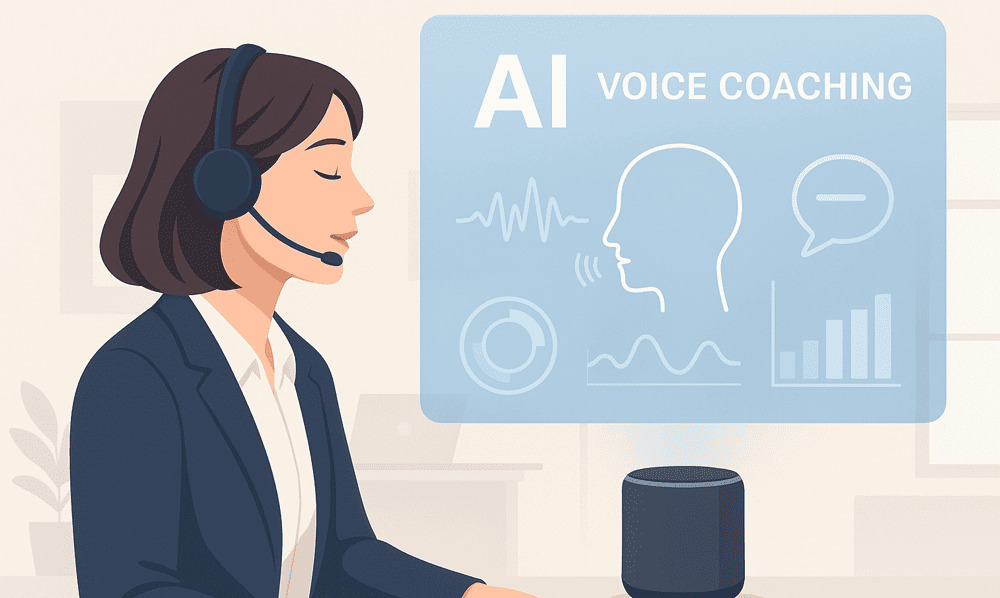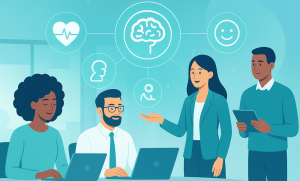In today’s fast-paced workplaces, employees often carry the weight of constant deadlines, meetings, and digital overload. The results are visible; fatigue, anxiety, and disengagement are climbing across industries. According to a 2024 Gallup report, 44% of workers say they feel stressed during most of their workday.
While organizations invest in wellbeing programs, access and engagement often remain a challenge. That’s where AI voice coaching steps in, offering personalized, conversational support employees can access anytime they need it.
What Is AI Voice Coaching?
AI voice coaching refers to digital voice-based assistants powered by conversational AI that offer real-time wellbeing and performance guidance. Unlike static apps or chatbots, these systems engage in spoken dialogue, allowing users to express emotions naturally.
Think of it as a personal wellbeing coach that listens, understands tone, and responds with empathy-driven guidance. Using conversational AI wellbeing technology, it can analyze vocal tone, pace, and energy levels to identify stress markers — responding with appropriate suggestions like breathing exercises, reframing prompts, or short relaxation sessions.
Core Capabilities Include:
- Voice-based emotional detection (tone, volume, hesitation cues)
- Personalized coaching responses tailored to each user’s voice data
- Integration with HR or wellbeing dashboards for organization-wide insights
- 24/7 conversational access: employees can talk whenever they need help
- Adaptive learning that improves with continued interaction
Why Voice Interaction Matters for Wellbeing
Text-based apps can feel transactional. Voice interaction, on the other hand, mimics human conversation — making wellbeing support more natural and less clinical.
Research Insight
A 2025 study by McKinsey showed that employees are 2.5x more likely to engage with a voice-based wellbeing tool compared to a text-only one. This is largely due to psychological safety, it feels like talking to a neutral, always-available listener.
In a typical day, an employee might say:
“I’m just exhausted after back-to-back meetings.”
The system can interpret emotional strain from voice modulation and respond:
“Sounds like your energy is low. Would you like a short 3-minute recharge exercise?”
This kind of stress voice support bridges the gap between self-awareness and timely intervention.
The Science Behind AI Voice Coaching
AI voice models today combine natural language processing (NLP), emotion analytics, and real-time coaching AI algorithms. Together, they create personalized wellbeing journeys that evolve with the user’s tone and behavioral data.
Key Functions Explained
| Function | Description | Example |
| Emotion recognition | Identifies stress, frustration, or calmness from speech tone | Detects tense voice and suggests calming exercises |
| Conversational flow | Engages users through open dialogue rather than pre-set options | Asks reflective questions: “What’s been most draining today?” |
| Personalized feedback | Tailors responses based on emotional cues | Offers guided breathing if tone shows strain |
| Workplace integration | Connects to existing wellbeing systems | Syncs with HR dashboards for aggregated insights |
With this setup, AI mental health voice technology acts as a “first line” of emotional support — recognizing early signs of burnout and prompting intervention before issues escalate.
Benefits of AI Voice Coaching for Organizations

1. 24/7 Emotional Support
Employees can talk to a workplace voice assistant anytime — during a stressful morning meeting, or late at night when they can’t sleep. It helps remove the stigma of asking for help.
2. Early Detection of Stress Trends
AI can detect subtle changes in voice tone or speech rhythm, offering managers anonymized reports on team stress levels. This can complement traditional AI coaching and pulse surveys for better wellbeing visibility.
3. Reducing Burnout and Absenteeism
With timely check-ins and reminders, AI voice coaching can help organizations reduce absenteeism caused by chronic stress or burnout.
4. Personalized Micro-Coaching
Instead of long, generic programs, AI voice systems provide quick interventions — a 5-minute grounding session, or a supportive reflection prompt when stress signals rise.
5. Seamless Integration
Modern systems integrate easily with AI onboarding coaching tools, Slack, Teams, or wellbeing dashboards, creating a unified employee support ecosystem.
Real-World Example
A global logistics firm piloted an AI voice coaching system across its warehouses in early 2025. Over six months:
- Employee stress mentions (detected via tone analysis) dropped by 22%
- Engagement with wellbeing tools increased by 38%
- HR reported fewer burnout-related leaves
Workers said they felt “heard” without judgment — the conversational aspect made it easier to open up than filling out wellness forms.
How AI Voice Coaching Enhances Mental Health Programs
Most organizations already have wellbeing initiatives — meditation apps, resilience training, or EAP access. However, engagement rates remain low (often under 10%).
AI voice systems enhance these programs by making them interactive and real-time. Instead of waiting for monthly wellness workshops, employees can speak to their AI mental health voice coach whenever they feel stressed.
Integration Opportunities
- Syncs with AI meditation tools for guided relaxation via voice.
- Works alongside AI for wellbeing dashboards to track progress over time.
- Complements traditional AI coaching modules by adding empathy-driven voice interactions.
Voice AI and Psychological Safety
Employees often hesitate to talk to managers or HR about stress. A digital voice coach creates psychological safety by being:
- Private – Conversations are confidential and anonymized.
- Non-judgmental – AI provides empathy without bias.
- Always available – Support doesn’t depend on human schedules.
This combination builds trust, encouraging employees to address challenges before they escalate.
“The best support systems don’t replace human empathy — they make it accessible when people need it most.”
Best Practices for Implementing AI Voice Coaching
To ensure adoption and long-term success:
- Start with pilot teams – Roll out to departments with known stress challenges.
- Communicate clearly – Explain privacy measures and goals upfront.
- Integrate with existing tools – Connect voice systems with your wellbeing platform or HRIS.
- Use analytics wisely – Focus on trends, not individual data.
- Provide human backup – Combine AI insights with professional counseling where needed.
The Future of Conversational AI in Workplace Wellbeing
The next generation of conversational AI wellbeing tools will go beyond reactive coaching. With real-time coaching AI, systems will proactively reach out when early signs of fatigue or emotional strain are detected in voice tone.
Imagine a workplace where:
- Your workplace voice assistant gently reminds you to stretch after long meetings.
- It offers a 2-minute relaxation audio when stress markers rise.
- It helps you practice mindfulness exercises through natural conversation.
That’s not science fiction — it’s the emerging reality of AI-enhanced wellbeing.
Conclusion
AI voice coaching represents a new chapter in workplace wellbeing — one that speaks the language of empathy through technology. For business leaders, it’s an opportunity to build more resilient, emotionally supported teams without adding workload or cost strain.
By combining AI coaching, AI meditation tools, and AI for wellbeing strategies, organizations can create a humanized digital support system that listens, understands, and responds in real time.
As work continues to evolve, conversational AI may soon become the friendly voice that helps every employee feel heard, supported, and emotionally balanced — one conversation at a time.







